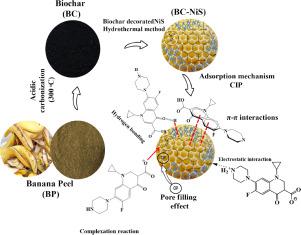Journal of Water Process Engineering ( IF 6.3 ) Pub Date : 2022-08-01 , DOI: 10.1016/j.jwpe.2022.103006 Ahmed B. Azzam , Yousif A. Tokhy , Farida M. El Dars , Ahmed A. Younes

|
The employment of residual biomass to produce promising sorbents with highly adsorption characteristics and their successful application for the removal of antibiotics from wastewater has gained considerable interest because of their low production cost and sustainability. Herein, the banana peel waste (BP), its modified biochar (BC), and activated biochar decorated with NiS (BC-NiS) were assessed as renewable adsorbents for efficient removal of ciprofloxacin antibiotic (CIP) from wastewater. The modification of BP with H3PO4 followed by the carbonization process produced porous banana peel biochar (BC) with larger acidic functional groups that formed on the carbon surface. This activation facilitated the effective synthesis of biochar decorated with NiS (BC-NiS) using a facile hydrothermal approach. The samples were characterized by XRD, FE-SEM, EDX, HR-TEM, BET, FTIR, and XPS analysis. The influence of operating factors including pH, contact time, initial CIP concentration, adsorbents dose, interfering ions, and solution temperature on the removal of ciprofloxacin by banana peel waste and its porous biochar modified with NiS was also evaluated. The maximum adsorption capacity of the BC-NiS hybrid structure was found to be 41.66 mg/g, which was highly effective compared with BP (20.83 mg/g) and BC (35.71 mg/g) for CIP removal without pH adjustment. A good fit was observed by the pseudo-second-order model and the Langmuir adsorption isotherm. The values of △ H° and △G° indicated the endothermic and spontaneous character of the adsorption process. The adsorption mechanism has been comprehensively elucidated by electrostatic interaction, π-π stacking, coordination affinities, and pore-filling effect. Desorption and recycling studies of the BC-NiS hybrid structure were also carried out to investigate its stability, and the results showed that it can be recycled without a substantial loss in the adsorption process after three recycle runs.
中文翻译:

NiS修饰多孔生物炭的构建去除制药废水中的环丙沙星抗生素
使用剩余生物质生产具有高吸附特性的有前途的吸附剂,并成功应用于从废水中去除抗生素,由于其低生产成本和可持续性而引起了相当大的兴趣。在此,香蕉皮废料 (BP)、其改性生物炭 (BC) 和用 NiS 装饰的活性生物炭 (BC-NiS) 被评估为可再生吸附剂,用于从废水中有效去除环丙沙星抗生素 (CIP)。H 3 PO 4对BP的改性随后的碳化过程产生了多孔香蕉皮生物炭(BC),在碳表面形成了较大的酸性官能团。这种活化促进了使用简便的水热方法有效合成用 NiS (BC-NiS) 装饰的生物炭。通过XRD、FE-SEM、EDX、HR-TEM、BET、FTIR和XPS分析对样品进行了表征。还评估了pH、接触时间、初始CIP浓度、吸附剂剂量、干扰离子和溶液温度等操作因素对香蕉皮废料及其NiS改性多孔生物炭去除环丙沙星的影响。BC-NiS 杂化结构的最大吸附容量为 41.66 mg/g,与 BP(20.83 mg/g)和 BC(35.71 mg/g)相比,无需调节 pH 即可去除 CIP。伪二级模型和朗缪尔吸附等温线观察到了良好的拟合。△H°和△G°的值表示吸附过程的吸热和自发特性。通过静电相互作用、π-π堆积、配位亲和力和孔填充效应,全面阐明了吸附机理。还对 BC-NiS 杂化结构进行了解吸和再循环研究,以研究其稳定性,结果表明,经过 3 次循环运行后,它可以在吸附过程中没有显着损失地循环使用。通过静电相互作用、π-π堆积、配位亲和力和孔填充效应,全面阐明了吸附机理。还对 BC-NiS 杂化结构进行了解吸和再循环研究,以研究其稳定性,结果表明,经过 3 次循环运行后,它可以在吸附过程中没有显着损失地循环使用。通过静电相互作用、π-π堆积、配位亲和力和孔填充效应,全面阐明了吸附机理。还对 BC-NiS 杂化结构进行了解吸和再循环研究,以研究其稳定性,结果表明,经过 3 次循环运行后,它可以在吸附过程中没有显着损失地循环使用。











































 京公网安备 11010802027423号
京公网安备 11010802027423号